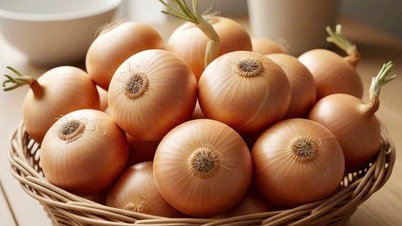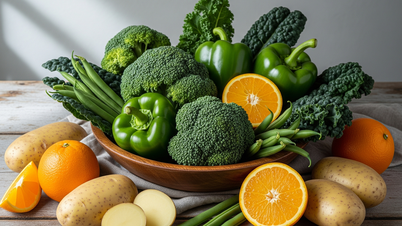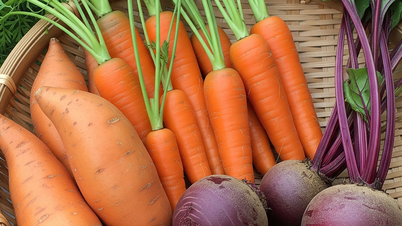
Sweet potatoes and potatoes both have their own advantages, from flavor, fiber, vitamins to disease prevention - Photo: FREEPIK
According to Prevention , sweet potatoes, potatoes, oranges, and tangerines all have their own advantages, from flavor, fiber, vitamins to disease prevention. Comparing not only helps to better understand the value of each type, but also helps to make reasonable choices, balancing nutrition in each meal.
Is it better to eat sweet potatoes or potatoes ?
According to the United States Department of Agriculture (USDA), 100g of cooked sweet potato with skin contains 90 calories; 2.01g of protein; 0g of fat; 20.7g of carbohydrates and 3.3g of fiber. According to the USDA, 100g of potato with skin contains 95 calories; 2.63g of protein; 0g of fat; 21.4g of carbohydrates and 2.3g of fiber.
The USDA says sweet potatoes are the top source of beta-carotene, beating out carrots and pumpkin, which are in second and third place, respectively. Sweet potatoes are also packed with nutrients, including soluble and insoluble fiber, vitamins C, B6, and niacin, and the minerals manganese, copper, and potassium.
A study published in Antioxidants notes that sweet potatoes also contain antioxidants that have anti-inflammatory properties, protect the liver and cardiovascular system, have anti-cancer properties, improve neurological function, aid in metabolic disorders, and enhance bowel function. Researchers also highlight that purple sweet potatoes, which get their color from a powerful group of antioxidants called anthocyanins, may help fight age-related diseases.
However, since sweet potatoes are high in starch, you need to pay attention to the carbohydrate content if you are monitoring your blood sugar. You also need to pay attention to the size of the sweet potato you eat, as sweet potatoes tend to be quite large, meaning they contain more carbohydrates.
Eating too many sweet potatoes can cause carotenemia - a condition in which the skin turns yellow-orange due to consuming too much carotene, the pigment that gives sweet potatoes their characteristic orange color.
Potatoes, on the other hand, are more nutritious than many people realize. A serving of potatoes provides you with fiber, vitamins C, B6, and folate, as well as the minerals potassium, manganese, and phosphorus.
Potatoes have a slightly higher fiber content than sweet potatoes, which offers benefits like increased satiety, reduced digestive problems, and better blood sugar balance, according to the Mayo Clinic .
According to research published in the journal Molecules , potatoes contain carotenoids, phenolic acids, anthocyanins, and flavonols, depending on the variety, all of which help fight inflammation and oxidative stress in the body.
Like sweet potatoes, potatoes have a significant amount of carbohydrates, which means you need to watch your intake if you're monitoring your blood sugar. The biggest downside to potatoes has more to do with how they're prepared—the most common being frying or adding salt. Both can increase saturated fat and sodium, which can be bad for your heart.
Orange or tangerine is better?
Tangerines and oranges are quite similar from a nutritional perspective. The USDA says a medium tangerine contains 47 calories; 1g protein; 0g fat; 12g carbohydrates; 1.58g fiber, while a navel orange contains 73 calories; 1g protein; 0g fat; 15g carbohydrates; and 2.8g fiber.
Tangerines provide vitamin C and potassium, which support immune function and electrolyte balance. According to the USDA, one tangerine contains about 24 milligrams (mg) of vitamin C. The recommended daily intake for women is 65mg and for men is 90mg.
Vitamin C has many important roles in the body, including boosting the immune system, supporting muscle growth and promoting collagen production, while potassium helps maintain proper kidney, nerve and cardiovascular function. Tangerines also contain vitamin A, B vitamins, copper and calcium.
This fruit is also a good source of fiber, supports healthy digestion, contains antioxidants, has anti-inflammatory properties and reduces the risk of chronic diseases. Research published in the journal Foods found that tangerine peels contain the most health-beneficial properties. These compounds are extracted and used as herbs or supplements in Oriental medicine.
Eating tangerines is not harmful for most people. However, people with diabetes who are closely monitoring their blood sugar levels should consider the natural sugars they contain. Although small, a tangerine contains about 9g of sugar, depending on its size.
Meanwhile, each orange provides 3g of fiber and a whole day's worth of vitamin C, meaning just one orange provides more vitamin C than a tangerine. The fiber content of oranges not only supports digestive health, but can also help lower cholesterol levels, benefiting heart health.
The antioxidants found in oranges and orange juice have been shown to improve some risk factors for cardiovascular disease, while substances in the peel may also benefit heart health. Oranges are also a good source of copper, potassium, calcium, and magnesium, which helps to replenish water through food.
However, people with acid reflux or gastroesophageal reflux disease (GERD) may want to avoid oranges because they can aggravate their symptoms. According to Johns Hopkins Medicine , citrus fruits can be a trigger for heartburn or acid reflux, especially if eaten at night.
Source: https://tuoitre.vn/loai-nao-tot-hon-khoai-lang-hay-khoai-tay-quyt-hay-cam-2025100118563388.htm



![[Photo] Bustling Mid-Autumn Festival at the Museum of Ethnology](https://vphoto.vietnam.vn/thumb/1200x675/vietnam/resource/IMAGE/2025/10/4/da8d5927734d4ca58e3eced14bc435a3)

![[Photo] Solemn opening of the 8th Congress of the Central Public Security Party Committee, term 2025-2030](https://vphoto.vietnam.vn/thumb/1200x675/vietnam/resource/IMAGE/2025/10/4/f3b00fb779f44979809441a4dac5c7df)
![[Photo] General Secretary To Lam attends the 8th Congress of the Central Public Security Party Committee](https://vphoto.vietnam.vn/thumb/1200x675/vietnam/resource/IMAGE/2025/10/4/79fadf490f674dc483794f2d955f6045)





















































![[VIDEO] Summary of Petrovietnam's 50th Anniversary Ceremony](https://vphoto.vietnam.vn/thumb/402x226/vietnam/resource/IMAGE/2025/10/4/abe133bdb8114793a16d4fe3e5bd0f12)
![[VIDEO] GENERAL SECRETARY TO LAM AWARDS PETROVIETNAM 8 GOLDEN WORDS: "PIONEER - EXCELLENT - SUSTAINABLE - GLOBAL"](https://vphoto.vietnam.vn/thumb/402x226/vietnam/resource/IMAGE/2025/7/23/c2fdb48863e846cfa9fb8e6ea9cf44e7)






























Comment (0)